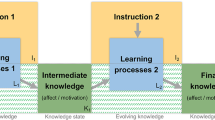Abstract
The present study examines how changes in the amount of on-screen text will influence student learning from a multimedia instructional unit on basic concepts of coordinate geometry. The relative effectiveness of two different versions (short-text and whole-text) of the instructional unit was examined for students who differed in terms of their ability to remember symbolic units, symbolic systems and symbolic interpretations. A total of 101 seventh graders were randomly assigned to work with either the whole-text or the short-text version. Student gains were analyzed using pre-test, post-test and retention test scores. Memory ability was assessed by the sub-tests of the Structure of Intellect-Learning Abilities Test. Results indicated no significant differences between groups who worked with short-text and whole-text versions. However retention scores of high and low memory groups who worked with the whole-text version showed significant differences. The whole-text version was observed to favor students with high memory for symbolic implications. Results suggest that workability of design principles for multimedia instruction may depend on the nature of the task and characteristics of the learner.

Similar content being viewed by others
References
Baddeley, A. (1992). Working memory. Science, 255, 556–559.
Guilford, J. P. (1967). The nature of human intelligence. New York: McGraw-Hill.
Gyselinck, V., Ehrlich, M. F., Cornoldi, C., de Beni, R., & Dubois, V. (2000). Visuospatial working memory in learning from multimedia systems. Journal of Computer Assisted Learning, 16, 166–176.
Jeung, H., Chandler, P., & Sweller, J. (1997). The role of visual indicators in dual sensory mode instruction. Educational Psychology, 17(3), 329–343.
Jonassen, D. H., & Grabowski, B. L. (1993). Handbook of individual differences, learning and instruction. Hilsdale, NJ: Erlbaum.
Mayer, R.E. (2001). Multimedia learning. Cambridge: Cambridge University Press.
Mayer, R. E., & Gallini, J. (1990). When is an illustration worth ten thousand words. Journal of Educational Psychology, 82, 715–726.
Mayer, R. E., Heiser, J., & Lonn, S. (2001). Cognitive constraints on multimedia learning: When presenting more material results in less understanding. Journal of Educational Psychology, 93(1), 187–198.
Mayer, R. E., & Moreno, R. (1998). A split attention effecting multimedia learning: Evidence for dual processing systems in working memory. Journal of Educational Psychology, 90(2), 312–320.
Mayer, R., & Sims, V. K. (1994). For whom is a picture worth a thousand words? Extention of a dual-coding theory of multimedia learning. Journal of Educational Psychology, 86, 389–401.
Meeker, M, & Meeker, R. J. (1983). Structure of intellect: Learning abilities test. Los Angeles: Western Psychological Services.
Moreno, R., & Mayer, R. E. (1999). Cognitive principles of multimedia learning: The role of modality and contiguity. Journal of Educational Psychology, 91, 358–368.
Moreno, R., & Mayer, R. E. (2000a). A coherence effect in multimedia learning: The case for minimizing irrelevant sounds in the design of multimedia instructional messages. Journal of Educational Psychology, 92(1), 117–125.
Moreno, R., & Mayer, R. (2000b). Meaningful design for meaningful learning: Applying cognitive theory to multimedia explanations. In World Conference on Educational Multimedia, Hypermedia and Telecommunications 2000(1) (pp. 782–787). [Online] Available: http://www.dl.aace.org/1387
Mousavi, S.Y., Low, R., & Sweller, J. (1995). Reducing cognitive load by mixing auditory and visual presentation modes. Journal of Educational Psychology, 87, 319–334.
Paivio, A. (1990). Mental representations: A dual coding approach. New York: Oxford University Press.
Park, O., & Etgen, M. P. (2000). Research based principles for multimedia presentation. In J. M. Spector & T. M. Anderson (Eds.), Integrated and holistic perspectives on learning, instruction and technology (pp. 197–212). Dordrecht, Netherlands: Kluwer Academic Publishers.
Sweller, J. (1994). Cognitive load theory: Learning difficulty and instructional design. Learning and Instruction, 4, 295–312.
Sweller, J., & Chandler, P. (1994) Why some material is difficult to learn. Cognition and Instruction, 12, 185–233.
Tindall-Ford, S., Chandler, P., & Sweller, J. (1997). When two sensory modes are better than one. Journal of Experimental Psychology, 3, 257–287.
Yee, P. L., Hunt, E. B., & Pellegrino, J. W. (1991). Coordinating cognitive information: task effects and individual differences in integrating information from several sources. Cognitive Psychology, 23, 615–680.
Author information
Authors and Affiliations
Corresponding author
Rights and permissions
About this article
Cite this article
Ardaç, D., Unal, S. Does the amount of on-screen text influence student learning from a multimedia-based instructional unit?. Instr Sci 36, 75–88 (2008). https://doi.org/10.1007/s11251-007-9035-4
Received:
Accepted:
Published:
Issue Date:
DOI: https://doi.org/10.1007/s11251-007-9035-4




